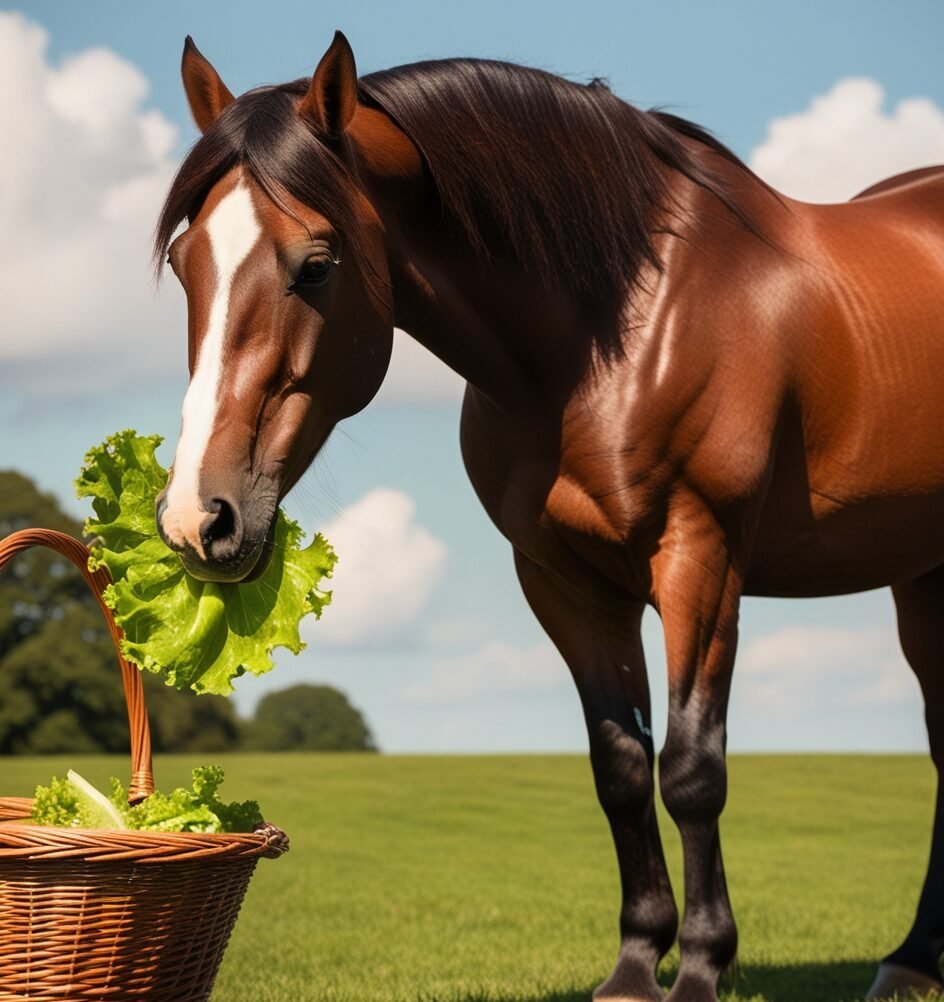Nutrition plays a crucial role in maintaining the health and well-being of horses. In this guide, we explore into the question of whether horses can safely consume lettuce and explore the nutritional benefits it can offer.
Understand the safety considerations, potential risks, and how lettuce can contribute to your horse’s diet.
Understanding the Nutritional Value of Lettuce
On a macronutrient level, lettuce is low in calories and carbohydrates, making it an excellent choice for those looking to add volume to their meals without significantly increasing their caloric intake.
Lettuce is mainly composed of water, providing hydration and a feeling of fullness without contributing many calories. It also contains a small amount of fiber, which is beneficial for digestive health.
Micronutrients in Lettuce
Little but mighty, lettuce offers a variety of important micronutrients that are important for overall health.
It is a good source of vitamins A, C, and K, which are antioxidants that help protect the body from damage caused by free radicals.
Additionally, lettuce contains minerals such as potassium and iron, which play crucial roles in various bodily functions.
Lettuce may seem like a basic salad ingredient, but its micronutrient profile makes it a valuable addition to a well-rounded diet.
Including a variety of lettuce types, such as romaine, arugula, and spinach, can provide a range of micronutrients to support optimal health.
Caloric Content of Lettuce
Lettuce is extremely low in calories, with most varieties containing less than 10 calories per cup, which makes it a great option for those who are watching their weight or looking to add bulk to their meals without significantly impacting their caloric intake.
The low caloric content of lettuce also makes it a versatile ingredient that can be used in large quantities to create filling and satisfying dishes.
When looking to increase the volume of your meals or add a crunchy element without adding excess calories, lettuce is a fantastic choice.
Its low caloric content combined with its high water and fiber content can help you feel full and satisfied while supporting your overall health and wellness goals.
Types of Lettuce Suitable for Horses
When feeding lettuce to horses, it’s important to choose types that are safe and provide some nutritional benefit without causing any adverse effects.
Here are some types of lettuce that are generally suitable for horses:
Romaine Lettuce
- Romaine lettuce is one of the best options for horses. It is rich in vitamins A, C, and K, as well as folate and dietary fiber.
- Introduce it slowly and in moderation. Cut it into manageable pieces to prevent choking.
Butterhead Lettuce (Bibb or Boston Lettuce)
- This type of lettuce is tender and contains vitamins A and K, as well as some dietary fiber.
- Like romaine, it should be given in moderation. Its soft leaves are easy for horses to chew and digest.
Leaf Lettuce (Green Leaf and Red Leaf)
- Leaf lettuce varieties are nutritious and provide vitamins A and K, folate, and antioxidants.
- These varieties have tender leaves that are easy for horses to eat. They should also be fed in moderation.
Escarole
- Escarole is a type of broad-leaved endive that is rich in vitamins A, K, and folate. It also has a slightly bitter taste that some horses might enjoy.
- Like other types, it should be introduced slowly and fed in small amounts.
Lettuce Types to Avoid or Feed with Caution
Iceberg Lettuce
- While not toxic, iceberg lettuce is not very nutritious and is mostly water. It provides little nutritional value and can lead to digestive upset if fed in large amounts.
- If you choose to feed iceberg lettuce, do so very sparingly and as an occasional treat.
General Guidelines for Feeding Lettuce to Horses
- Lettuce should be a treat, not a staple. Horses’ diets should primarily consist of forage (hay or grass).
- Always wash lettuce thoroughly to remove any pesticides or contaminants.
- Introduce any new food, including lettuce, gradually to monitor for any adverse reactions.
- Keep portions small to prevent digestive issues.
- Ensure the lettuce is fresh and free from wilting or spoilage.
Romaine, butterhead, leaf lettuce, and escarole are suitable and nutritious options for horses when fed in moderation.
Avoid or limit iceberg lettuce due to its low nutritional value. Always introduce new foods slowly and monitor your horse for any signs of digestive discomfort or allergic reactions.
Factors to Consider Before Feeding Lettuce to Horses

Feeding lettuce to horses can be a healthy treat, but there are several factors to consider to ensure it’s safe and beneficial. Here are the key considerations:
Nutritional Content
Some types of lettuce, such as romaine and leaf lettuce, are rich in vitamins A, K, and C. However, lettuce is generally low in calories and may not significantly contribute to the horse’s overall nutrient requirements.
Lettuce has a high water content, which can be beneficial for hydration but may also cause digestive issues if fed in large quantities.
Digestive Health
Horses need a high-fiber diet primarily from hay and grass. Lettuce lacks the necessary fiber content and should not replace their main forage.
Introducing any new food can cause digestive upset. Lettuce should be introduced gradually to monitor for any adverse reactions such as diarrhea or colic.
Types of Lettuce
These are generally safe and nutritious options. They provide some vitamins and are easy for horses to chew and digest.
Should be fed sparingly if at all, due to its low nutritional value and high water content, which can lead to digestive issues.
Portion Size
Lettuce should be fed in small amounts as an occasional treat. Overfeeding can lead to digestive problems.
Ensure the lettuce is cut into manageable pieces to prevent choking.
Health Conditions
Horses with metabolic issues, such as insulin resistance or equine metabolic syndrome (EMS), should have their sugar and carbohydrate intake closely monitored. Lettuce generally has low sugar content but should still be fed cautiously.
Horses with dental problems may have difficulty chewing certain types of lettuce, particularly tougher leaves.
Environmental and Safety Concerns
Always wash lettuce thoroughly to remove pesticides, dirt, and other contaminants that could be harmful to horses.
Ensure the lettuce is fresh and free from spoilage. Wilted or spoiled lettuce can cause digestive upset.
Introduction and Observation
Introduce lettuce slowly into the horse’s diet to watch for any adverse reactions.
Observe the horse after feeding lettuce for any signs of discomfort, allergic reactions, or changes in behavior and droppings.
Overall Diet Balance
Lettuce should not replace the primary components of a horse’s diet, which should consist mainly of high-fiber forage like hay and grass.
Ensure the overall diet remains balanced and meets all the horse’s nutritional needs.
So, Feeding lettuce to horses can be a healthy treat when done in moderation. Choose nutrient-rich types like romaine, butterhead, and leaf lettuce, and avoid or limit iceberg lettuce.
Introduce lettuce gradually, ensure it is clean and fresh, and monitor your horse for any adverse reactions.
Step-by-Step Guide to Introducing Lettuce into a Horse’s Diet
For horse owners looking to add lettuce to their equine companion’s diet, it’s important to do so gradually and with caution. Here is a step-by-step guide to safely introducing lettuce into a horse’s diet.
Start with Small Amounts
| Step | Details |
| 1 | Start by offering a small amount of lettuce, such as a few leaves, to assess your horse’s reaction. |
| 2 | Monitor your horse for any signs of digestive upset, such as diarrhea or colic. |
Monitor for Adverse Reactions
An imperative part of introducing any new food into a horse’s diet is monitoring for adverse reactions.
If your horse shows any signs of discomfort or digestive issues after consuming lettuce, it’s crucial to stop feeding it immediately and consult with your veterinarian.
For instance, if your horse experiences loose stools or changes in behavior after eating lettuce, it may be a sign that their digestive system is having trouble processing the new food.
Gradually Increase Lettuce Intake
| Step | Details |
| 1 | If your horse tolerates the initial small amount of lettuce well, gradually increase the portion size over a few days. |
| 2 | Monitor your horse closely for any changes in behavior or digestion as you increase the amount of lettuce in their diet. |
An important point to consider while gradually increasing lettuce intake is to ensure that it complements the horse’s existing diet and does not replace imperative nutrients from other feed sources.
Pros and Cons of Feeding Lettuce to Horses
| Benefits | Potential Risks |
| Low in calories | Possible digestive upset |
| Rich in vitamins A and K | Risk of choking |
| Hydrating | Excessive consumption may lead to imbalanced diet |
Benefits of Lettuce for Horse Health
On top of being low in calories, lettuce is a good source of vitamins A and K, which are vital for a horse’s overall well-being.
These vitamins play crucial roles in maintaining healthy vision, immune function, and blood clotting.
Lettuce’s high water content also helps keep horses hydrated, especially during hot weather or after strenuous physical activity.
Potential Risks and Drawbacks
Lettuce can pose risks to horses if not fed properly. The potential for digestive upset exists due to horses having sensitive stomachs that may not handle sudden dietary changes well.
Potential choking hazards are also a concern when feeding lettuce, especially if it is not cut into small, manageable pieces.
Horses may not properly chew their food, leading to a higher risk of choking episodes.
Tips for Preparing and Serving Lettuce to Horses
Lettuce can be a refreshing and fun treat for your equine friend, but it’s all about preparation and portion control.
Here’s how to ensure your horse enjoys a safe and delicious lettuce snack:
- Washing is Essential: Get rid of any dirt, pesticides, or fertilizer residue. Wash the lettuce thoroughly under clean running water, separating the leaves as you go.
- Chopping Time: Horses can choke on large pieces, so chop or tear the lettuce into bite-sized chunks. This is especially important for iceberg lettuce, which has a firmer texture.
- Freshness Matters: Only offer crisp, fresh lettuce. Avoid wilted, slimy, or discolored leaves, as they can cause digestive issues.
- Variety is Key: While lettuce is okay, consider a veggie medley! Mix chopped lettuce with other horse-safe fruits and vegetables like carrots, apples (core removed!), or berries for a more exciting and nutritious treat.
- Think Outside the Bowl: Instead of just handing over the lettuce, get creative! Sprinkle chopped lettuce over your horse’s regular hay for a bit of extra flavor and foraging fun.
- Portion Patrol: Remember, lettuce is a treat, not a meal replacement. A small handful is more than enough for most horses.
- Start Slow: As with any new food, introduce lettuce gradually. Begin with a tiny amount and monitor your horse for any signs of digestive upset. If all goes well, you can slowly increase the quantity over time.
Final Words
Therefore, it is advisable to feed lettuce to horses in moderation and as a periodic indulgence rather than a regular component of their diet.
While lettuce can provide some nutritional benefits, excessive amounts can lead to potential digestive issues.
It is essential to prioritize a horse’s primary diet of high-quality hay, grains, and appropriate supplements to ensure they receive all the necessary nutrients for optimal health and well-being.
